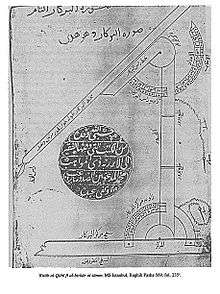Al-Birjandi
| al-Birjandi | |
|---|---|
|
A work of al-Birjandi's, Sharh al-Tadhkirah, a manuscript copy, beginning of the 17th century | |
| Native name | ʿAbd al‐ʿAlī ibn Muḥammad ibn Ḥusayn al‐Birjandī |
| Died | 1525-1526 |
| Academic background | |
| Influences | Naṣīr al‐Dīn al‐Ṭūsī, al-Kashi |
| Academic work | |
| Era | Islamic Golden Age |
Abd Ali ibn Muhammad ibn Husayn Birjandi (Persian: عبدعلی محمد بن حسین بیرجندی) (died 1528) was a prominent 16th-century Persian astronomer, mathematician and physicist who lived in Birjand.
Astronomy
In discussing the structure of the cosmos, al-Birjandi continued Ali al-Qushji's debate on the Earth's rotation.[1][2][3] In his analysis of what might occur if the Earth were moving, he develops a hypothesis similar to Galileo Galilei's notion of "circular inertia",[4] which he described in the following observational test (as a response to one of Qutb al-Din al-Shirazi's arguments):
"The small or large rock will fall to the Earth along the path of a line that is perpendicular to the plane (sath) of the horizon; this is witnessed by experience (tajriba). And this perpendicular is away from the tangent point of the Earth’s sphere and the plane of the perceived (hissi) horizon. This point moves with the motion of the Earth and thus there will be no difference in place of fall of the two rocks."[5]
Works
Al-Birjandi wrote some more than 13 books and treatises, including:[6]
- Sharh al-tadhkirah (A commentary on al-Tusi's memoir). The text, in some copies of the manuscript from 17th century, is written throughout in black and red ink with diagrams illustrating many of the astronomical elements discussed.[7] The 11th chapter of the book was translated to Sanskrit in 1729 at Jaipur by Nayanasukhopadhyaya. Kusuba and Pingree present an edition of the Sanskrit, and in a separate section, an English translation facing the Arabic original. That chapter has attracted attention among European scholars since the late 19th century.[8] Al-Birjandi on Tadhkira II, Chapter 11, and Its Sanskrit Translation by Kusuba K. and Pingree D. ISBN 978-90-04-12475-2 was published in 2001 by Brill Academic Publishers.
- Sharh-i Bist Bab dar Ma'rifat-i A'mal-i al-Asturlab (Commentary on "Twenty Chapters Dealing with the Uses of the Astrolabe" of Nasir al-Din al-Tusi; Persian.[9]
- Risalah fi Alat al-Rasad (Epistle on observational instruments); in Arabic.
- Tadhkirat al-Ahbab fi Bayan al-Tahabub (Memoir of friends: concerning the explanation of friendship [of numbers]); in Arabic.
He also wrote on theology.
See also
References
- ↑ Ragep, F. Jamil (2001b). "Freeing Astronomy from Philosophy: An Aspect of Islamic Influence on Science". Osiris, 2nd Series. 16 (Science in Theistic Contexts: Cognitive Dimensions): 49–64 & 66–71. doi:10.1086/649338.
- ↑ Ragep, F. Jamil (2001a). "Tusi and Copernicus: The Earth's Motion in Context". Science in Context. Cambridge University Press. 14 (1-2): 145–163. doi:10.1017/s0269889701000060.
- ↑ Kusuba, Takanori (2007). "Birjandī: ʿAbd al‐ʿAlī ibn Muḥammad ibn Ḥusayn al‐Birjandī". In Thomas Hockey; et al. The Biographical Encyclopedia of Astronomers. New York: Springer. p. 127. ISBN 978-0-387-31022-0. (PDF version)
- ↑ (Ragep 2001b, pp. 63–4)
- ↑ (Ragep 2001a, pp. 152–3)
- ↑ Encyclopaedia Iranica
- ↑ The Institute of Ismaili Studies - The Calligraphic Tradition in Islam
- ↑ Powell's Books - Islamic Philosophy, Theology, and Science, #47: Arabic Astronomy in Sanskrit Arabic Astronomy in Sanskrit: Al-Birjand? on Tadhkira II, Chapter 11 and Its Sanskrit Tranal-Birjand? on Tadhkira II, Cha by Takanori Kusuba
- ↑ Manuscript Exhibition 2007
This article is issued from Wikipedia - version of the 9/22/2016. The text is available under the Creative Commons Attribution/Share Alike but additional terms may apply for the media files.

